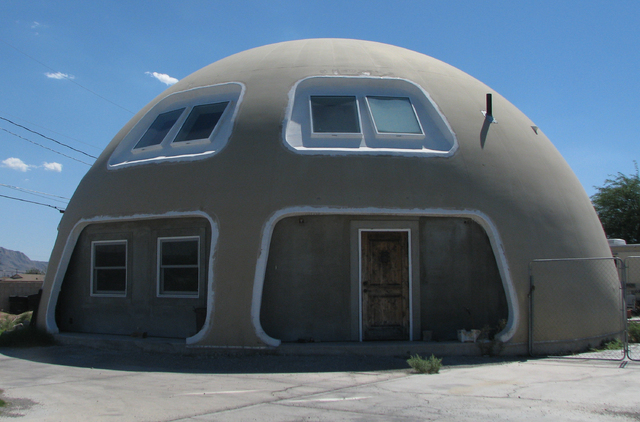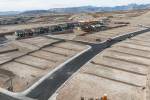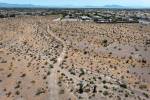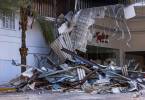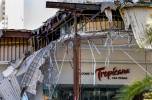Dome to put lid on public tours
The domes are advertised as “tomorrow’s building available today,” which is exactly what caught Su-z Allen and her husband David’s eye in the first place. The dome structures looked like nothing they had ever seen before.
Allen said it started in 1991 when she and David were driving along a Texas highway, and she saw a couple of domes in the distance. The couple became captivated enough to stop and take a tour inside the structures built by Monolithic Domes.
“They caught our attention,” Allen said. “They’re definitely unique, which is what I wanted for my house.”
Allen contacted the Texas-based company 16 years later and started the construction of their own residential dome. Allen’s dome, dubbed the “Fenix Dome,” has been under construction since 2007. Allen said she chose that name because the dome “rose from the ashes of our old house.”
“I was discussing with a contractor about putting monolithic skin on the outside of our old house,” Allen said. “He said it wouldn’t be a problem, but then that same afternoon the roof caught on fire from the air conditioner. We decided to demolish the whole thing and (build our dome).”
After the fire engulfed her home in 2005, Allen waited two years to get the necessary design and permits ready for the dome. She used all of her insurance money from the fire to start construction.
Monolithic Domes started the initial process by creating an inflatable “Monolithic Airform,” described as a steel-reinforced concrete and polyurethane foam insulation.
Gary Clark, vice president of sales at Monolithic Domes, describes the process as similar to baking a Bundt cake.
“We inflate the Airform, and after it’s inflated, all of the construction work takes place on the inside,” Clark said. “The process takes about one week.”
He added that the company has built domes in 49 states and 52 countries and that the price of the dome is similar to the cost of a regular house.
According to Monolithic Domes’ website, monolithic.com, each dome meets Federal Emergency Management Agency standards for “providing near-absolute protection and have a proven ability to survive tornadoes, hurricanes, earthquakes, fire and termites.”
Ray Ansel, founder of R&S Life Line Domes, was hired as the contractor of the Fenix Dome. Clark said president and founder of Monolithic Domes, David South, trained Ansel.
“Domes have become so popular, not only because they can survive natural disasters but also because they save around 50 to 70 percent in heating and cooling,” Ansel said. “Right now, they’re going for $138 per square foot.”
Allen attests to the durability of the dome by claiming that she has not had any problems with termites and that she cannot even hear the wind blowing during stormy nights.
“They should be building these everywhere, especially in Hurricane Alley and in areas where there are tornados,” Allen said.
Another perk of having a house dome, according to Allen, is saving money because the dome is energy-efficient.
“It stays cooler when it’s hot and warmer when it’s cold,” Allen said.
Yet with all of its advantages, finishing the construction of the dome has been an ongoing challenge. Six years after starting, the couple’s dome is almost near completion. Allen said it was the lack of financial support that had them stalled for a year.
“I went for a whole year without doing anything, but then I got a letter saying that if you didn’t do something soon, we’re going to consider it abandonment,” Allen said. “I started using my unemployment money to get things rolling again. Money has always been the biggest challenge. We’re taking it day by day.”
The Allens are living in a mobile home behind the dome. They must wait until they receive a Certificate of Occupancy in order to move into their dome. They have drifted between contractors to finish the plumbing, painting, upstairs basement and trim around the doors and windows.
The Fenix Dome is a 3,800-square-foot, two-story half-sphere. The dome contains two bedrooms, a master suite upstairs and a guest room in the main floor. The main floor also has a living room, a dining area and a kitchen.
“The neighbors showed up during our first open house. They were interested in how it would turn out,” Allen said. “They were not overly excited, but they weren’t negative, either.”
Allen’s friend, who would like to remain anonymous, said Allen was trying to convince her to build a dome similar to hers.
“I like her dome in a way and in a way I don’t,” she said. “I don’t like the cement floors. I don’t really care for them. I do like the idea that it’s different from what normal people live in.”
Allen said she has scheduled the last tour of her dome for this month. After the construction of her home is complete, she prefers to have privacy.
“Overall I’m happy with the way my dome is turning out,” she said. “Even though it’s not going to be to the standards I wanted it, I’m anxious to move in.”
The Fenix Dome at 4243 E. Carey Ave. has scheduled its last tour from 10 a.m. to 4 p.m. Oct. 19. Donations for admittance will be accepted on behalf of Small Paws Rescue.
For more information, visit monolithic.com/topics/residential-dome-tour.
Contact Sunrise/Whitney View reporter Sandy Lopez at slopez@viewnews.com or 702-383-4686.



